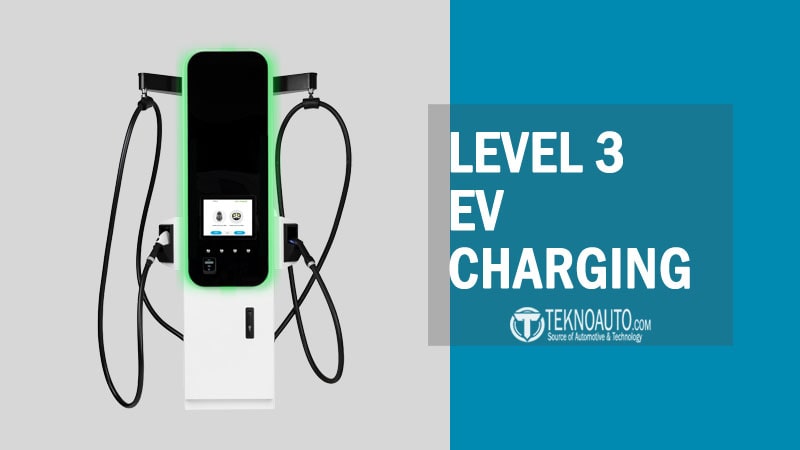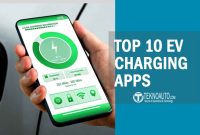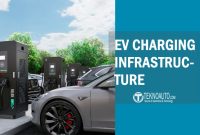While most EV owners start with Level 1 EV Charging or Level 2 EV Charging at home, the need to recharge quickly—especially during long trips or in urban environments—has made Level 3 EV charging, also known as DC Fast Charging, an essential part of the electric vehicles (EVs) ecosystem.
Unlike standard charging methods that rely on alternating current (AC), Level 3 chargers deliver direct current (DC) directly to your vehicle’s battery, significantly reducing the time needed to replenish energy. For many drivers, this can mean going from nearly empty to 80% charge in as little as 20–40 minutes. But speed comes with trade-offs, including cost, compatibility, and potential battery wear.
In this guide, we’ll break down how Level 3 EV charging works, what sets it apart from Level 1 and Level 2 systems, how much it really costs to use, and where you can reliably find DC Fast Charging stations. Whether you’re new to electric vehicles or just looking to get the most out of your charging experience, this article will help you make informed decisions about high-speed EV charging.
What Is Level 3 EV Charging?
Level 3 EV charging, commonly referred to as DC Fast Charging, represents the fastest publicly available charging option for electric vehicles. Unlike Level 1 and Level 2 chargers that use alternating current (AC) and rely on the vehicle’s onboard converter to convert electricity into direct current (DC), Level 3 chargers deliver DC power directly to the EV’s battery, bypassing the onboard charger and significantly reducing charging time.
Voltage, Power Output, and Speed
Level 3 charging systems typically operate at 400 to 1000 volts and can deliver between 50 kW to 350 kW of power. This high-voltage, high-current delivery allows EV batteries to be charged at an exceptionally fast rate—making it possible to gain 60–80% battery capacity in just 15 to 40 minutes, depending on the vehicle and charger specifications.
| Charging Level | Power Output | Charging Time (0–80%) | Connector Type |
|---|---|---|---|
| Level 1 | 1–1.9 kW | 20–40 hours | Standard 120V outlet |
| Level 2 | 3.3–19.2 kW | 4–10 hours | J1772 / Tesla Wall Connector |
| Level 3 (DCFC) | 50–350 kW | 15–40 minutes | CCS, CHAdeMO, NACS |
The faster speed is ideal for:
- Long-distance travel
- Urban EV drivers without home charging
- Commercial or fleet vehicles that require quick turnaround
Infrastructure Requirements
Because of their high energy output, Level 3 chargers require more robust infrastructure, including:
- High-capacity grid connections
- Dedicated transformers or substations
- Active cooling systems (especially for chargers rated above 150 kW)
For this reason, Level 3 chargers are usually installed in commercial settings—such as along highways, in shopping centers, or at EV charging hubs—not in residential homes.
Types of Connectors

There are three main types of connectors used for Level 3 EV charging:
- CCS (Combined Charging System):The most widely adopted standard in North America and Europe; compatible with most modern EVs (Ford, GM, Hyundai, Kia, VW, etc.).
- CHAdeMO: Used primarily by older Nissan EVs (e.g., Leaf), but being phased out in most markets.
- NACS (North American Charging Standard): Originally proprietary to Tesla, but rapidly becoming the dominant standard as major automakers adopt it.
Where It Fits in the Charging Ecosystem
While Level 1 and Level 2 chargers are ideal for overnight or daily home use, Level 3 EV charging is designed for rapid energy top-ups in public or fleet-oriented environments. It plays a critical role in enabling longer EV trips, expanding public charging infrastructure, and reducing “range anxiety.”
DC Fast Charging vs Level 2: Key Differences

While both Level 2 and Level 3 charging solutions are faster alternatives to the standard wall outlet (Level 1), they serve very different purposes and require very different infrastructure. Understanding how DC Fast Charging (Level 3) compares to Level 2 charging can help you choose the right solution for your needs—whether it’s for daily home use, road trips, or commercial operations.
1. Power Output and Charging Speed
The most noticeable difference is how fast each option can charge your vehicle:
| Feature | Level 2 Charging | Level 3 Charging (DC Fast) |
|---|---|---|
| Power Output | 3.3 to 19.2 kW | 50 to 350+ kW |
| Voltage | 240V AC | 400V–1000V DC |
| Average Charge Time | 5–6 hours (0–100%) | 15–45 minutes (0–100%) |
| Ideal Use Case | Home charging, overnight | Public stations, long trips |
While Level 2 can add 20–40 miles of range per hour, DC Fast Charging can deliver up to 180–250+ miles in under 30 minutes for compatible EVs.
2. Charging Location and Accessibility
- Level 2 Chargers are typically installed at home, workplaces, or small commercial sites. They’re cost-effective and easy to set up with a 240V connection.
- DC Fast Chargers require specialized infrastructure—including high-voltage grid access and cooling systems—so they’re usually found at:
- Highway rest stops
- Retail centers
- Fleet depots
- Dedicated fast-charging hubs
You cannot install Level 3 charging at a typical home due to grid limitations and cost.
3. Cost per Charging Session
- Level 2: Most home users pay residential electricity rates (e.g., $0.13–$0.25 per kWh). A full charge may cost $4–$9.
- DC Fast Charging: Public networks often charge per kWh, per minute, or by session, with rates ranging from $0.25 to $0.69 per kWh. A typical session may cost $15–$30, depending on your vehicle’s battery size and charger speed.
4. Battery Health Considerations
- Frequent DC Fast Charging can accelerate battery degradation due to heat and high current loads—especially in older EV models or vehicles with passive thermal management.
- Level 2 charging is gentler on battery chemistry, making it the better choice for routine, daily charging.
5. Charging Connector Types
- Level 2: Uses the J1772 standard (or Tesla Wall Connector)
- Level 3: Uses CCS, CHAdeMO, or NACS—depending on the vehicle
Understanding connector types is essential for ensuring compatibility during public charging.
How Does DC Fast Charging Work?
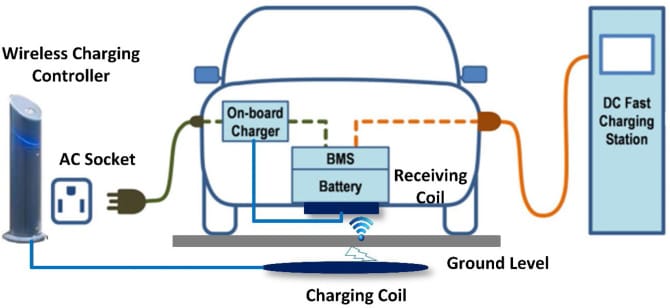
To understand what makes DC Fast Charging (Level 3 EV Charging) so much faster than Level 1 or 2, you need to look at the way electric vehicles handle electricity. At the core of it, Level 3 charging works by delivering direct current (DC) electricity straight to the vehicle’s battery, eliminating the conversion process that slows down lower-level charging.
AC vs. DC: The Fundamental Difference
- Level 1 and Level 2 chargers provide alternating current (AC), which must be converted to direct current (DC) by the EV’s onboard charger before it can charge the battery.
- In contrast, Level 3 chargers convert AC to DC externally—right inside the charging station—then deliver DC directly to the battery, bypassing the slower onboard system.
This direct route eliminates bottlenecks and allows significantly higher power levels, making ultra-fast charging possible.
Bypassing the Onboard Charger
Every EV has a built-in onboard charger that manages how AC power is converted and distributed to the battery. These onboard chargers typically max out at 6.6–11.5 kW (or up to 19.2 kW in high-end vehicles), limiting how quickly an EV can charge on Level 2.
But with Level 3/DCFC, the onboard charger is bypassed entirely, and the power goes straight to the battery management system (BMS), allowing for:
- Faster current delivery
- Higher efficiency
- Less conversion heat loss
Understanding Charging Curves
DC fast charging doesn’t deliver full-speed power from start to finish. Instead, EV batteries follow a charging curve:
- Initial Ramp-Up: When the battery is low (e.g., 0–20%), the system charges at near-maximum speed.
- Constant High Power: Between 20–80%, most chargers sustain high output (e.g., 100–250 kW), depending on the vehicle’s capabilities.
- Tapering Down: Once 80% is reached, charging speed drops significantly to prevent overcharging and reduce battery stress.
This is why most fast-charging sessions target 0–80%, as the last 20% can take nearly as long as the first 80%.
Thermal Management and Safety
DC fast charging generates a significant amount of heat, both in the battery and charging cable. That’s why:
- Many Level 3 chargers use liquid-cooled cables
- EVs rely on active thermal management to maintain battery temperature
- Some vehicles automatically slow charging if temperatures rise too quickly
Proper cooling is essential not only for charging speed but also for battery longevity and safety.
Communication Between Charger and Vehicle
Before charging begins, the EV and charger engage in a high-speed digital handshake, negotiating:
- Charging voltage and current
- Battery status and temperature
- Power limits
- Safety protocols
Only after both systems agree on parameters does the power flow begin, ensuring safe and optimized delivery for both the battery and charger hardware.
Compatibility: Which EVs Can Use Level 3 Charging?
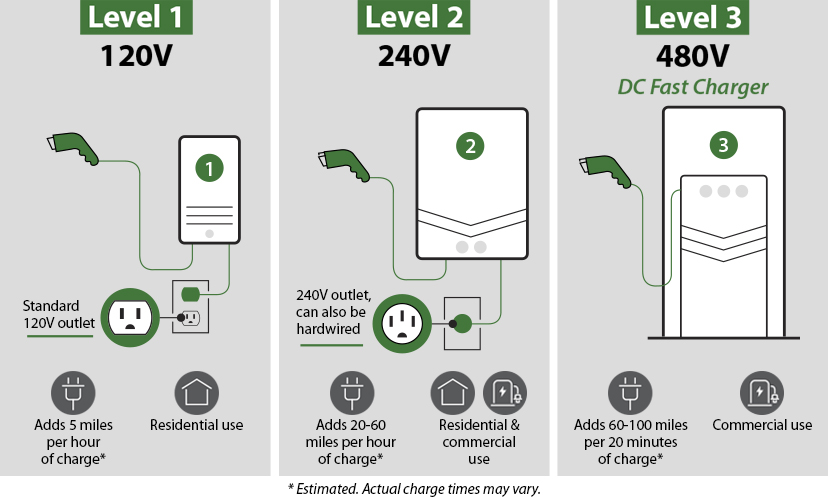
Not all electric vehicles (EVs) are created equal when it comes to Level 3 EV charging. While nearly every modern battery electric vehicle (BEV) supports some form of DC Fast Charging, the extent of that support—speed, connector type, and efficiency—depends on the vehicle’s hardware and charging architecture.
EV Types That Support Level 3 Charging
| EVs Type | Supports Level 3 Charging? | Notes |
|---|---|---|
| BEV (Battery Electric Vehicle) | Yes | Most modern BEVs support DC fast charging |
| PHEV (Plug-in Hybrid EV) | No | Most PHEVs only support Level 1 or 2 charging |
| HEV (Hybrid Electric Vehicle) | No | Not plug-in capable; no charging port |
| FCEV (Fuel Cell EV) | No | Uses hydrogen, not electricity from the grid |
Connector Standards and Compatibility
EVs in North America support one of the following fast charging connectors:
- CCS (Combined Charging System)
The most common standard across non-Tesla EVs (e.g., Ford, GM, Hyundai, VW, Kia). CCS combines AC and DC in a single port. - CHAdeMO
Used primarily by older Nissan Leafs and the Mitsubishi Outlander PHEV. This format is being phased out in favor of CCS. - NACS (North American Charging Standard)
Originally developed by Tesla, this connector is now being adopted by major automakers like Ford, GM, Rivian, and Hyundai for their future models. Tesla Superchargers use NACS, and adapters are available for CCS vehicles.
| Connector Type | Supported Brands |
|---|---|
| CCS | Ford, Volkswagen, BMW, Mercedes, Hyundai, Kia, GM, Volvo, etc. |
| CHAdeMO | Older Nissan, Mitsubishi |
| NACS (Tesla) | Tesla (natively); Ford, GM, and others (via adapter or direct) |
Minimum Battery Requirements
Level 3 charging is generally supported by EVs with larger battery capacities, typically 30 kWh and above. Vehicles with small batteries may not benefit from DC Fast Charging due to:
- Limited power acceptance
- Low overall range gains
- Cost inefficiency for short-range gains
Tesla Vehicles
All Tesla models (Model 3, Y, S, and X) support DC fast charging via Tesla Supercharger stations using the proprietary NACS connector. They can also charge at non-Tesla Level 3 stations if using a CCS adapter, which Tesla began rolling out in select regions.
Charging Speed Limitations
Even if your EV supports Level 3 charging, the maximum rate depends on your vehicle’s DC input limit. For example:
- Hyundai Ioniq 5: up to 235 kW (800V architecture)
- Chevrolet Bolt EV: up to 55 kW (limited DC speed)
- Tesla Model 3: up to 250 kW (with V3 Superchargers)
- Nissan Leaf (CHAdeMO): up to 50 kW
If you plug a vehicle that maxes out at 50 kW into a 350 kW charger, it will still only draw what it can handle.
Costs of Using Level 3 EV Chargers
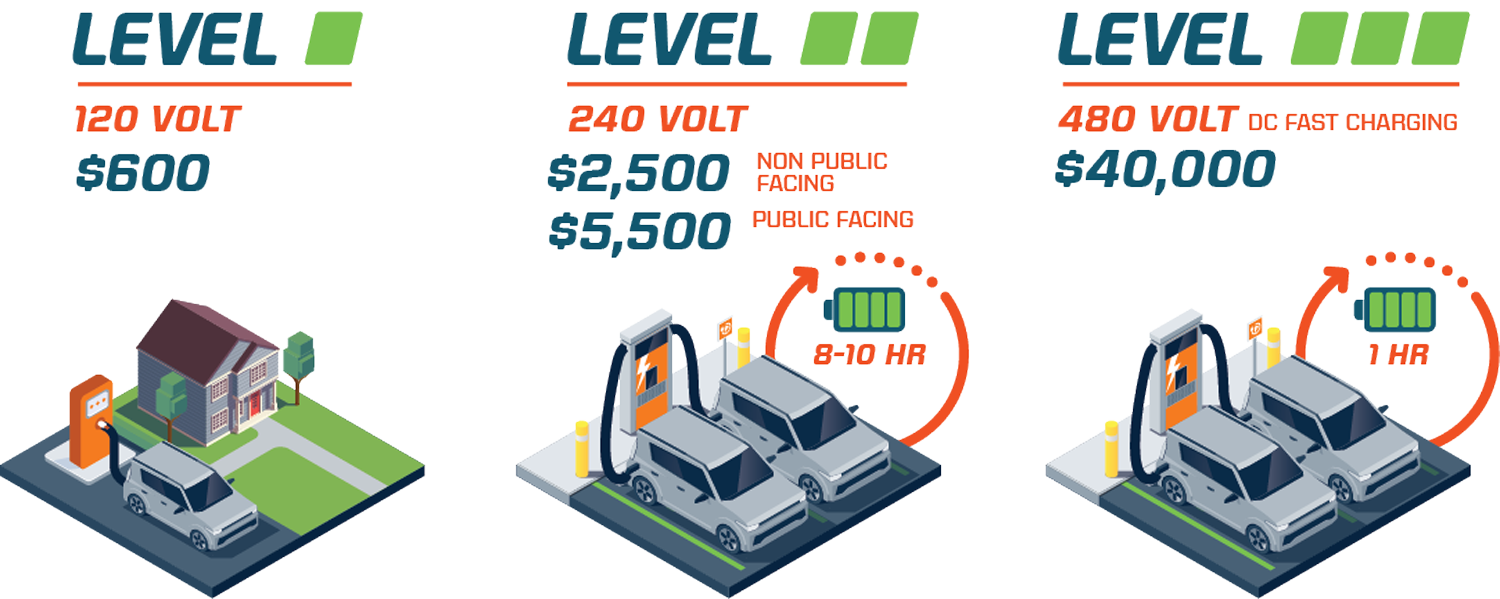
Level 3 EV charging offers unmatched speed, but that speed comes at a price. Unlike Level 1 or Level 2 charging—often done at home using standard utility rates—DC Fast Charging is primarily available through public charging networks, which often use tiered pricing models and may vary by provider, location, or time of day.
How Much Does DC Fast Charging Cost?
The cost of a Level 3 charging session depends on several factors:
- Charging network (e.g., Electrify America, EVgo, Tesla Supercharger)
- Location and electricity rates
- Charging method (kWh vs per-minute)
- Vehicle battery size and charge level
| Charging Network | Typical Rate per kWh | Membership Discount Available? |
|---|---|---|
| Tesla Supercharger | $0.25–$0.35 per kWh | No (flat rate) |
| Electrify America | $0.43–$0.69 per kWh | Yes (Pass+ members) |
| EVgo | $0.30–$0.49 per kWh | Yes (monthly plans) |
| ChargePoint (varies) | $0.20–$0.55 per kWh | Operator dependent |
Average cost per session: For a typical EV with a 60 kWh battery, charging from 10% to 80% may cost $12–$25, depending on speed and rate.
Per-Minute vs Per-kWh Billing
Some networks bill by the minute, especially in states where per-kWh pricing is restricted due to utility regulations. This can penalize drivers of EVs that charge slowly on DCFC.
| Billing Method | Pros | Cons |
|---|---|---|
| Per kWh | Fair billing based on energy used | May be higher in peak hours |
| Per minute | Good for fast-charging vehicles | Penalizes slower-charging EVs |
Idle Fees and Overstay Penalties
To keep chargers available, many networks impose idle fees after a session is complete. For example:
- Tesla: $0.50–$1.00 per minute if car remains plugged in after session ends
- EVgo & EA: Similar charges kick in after 10-minute grace period
Always monitor your session and move your vehicle when charging is complete.
Time-of-Use Pricing and Peak Hours
Some fast-charging stations adjust prices based on time-of-use (TOU) or grid demand. You may pay more during:
- Rush hours (4 PM – 9 PM)
- Extreme weather days
- Weekend/holiday travel peaks
Is DC Fast Charging Cheaper Than Gas?
In most cases, yes—but not by much:
- Gasoline: $3.50–$5.00 per gallon
- EV DC Charging: ~$0.40 per kWh
→ Equivalent cost per mile is often lower, especially for efficient EVs.
However, frequent use of Level 3 charging may cancel out savings from home charging, where rates can be as low as $0.10–$0.15 per kWh.
Where to Find Level 3 Charging Stations
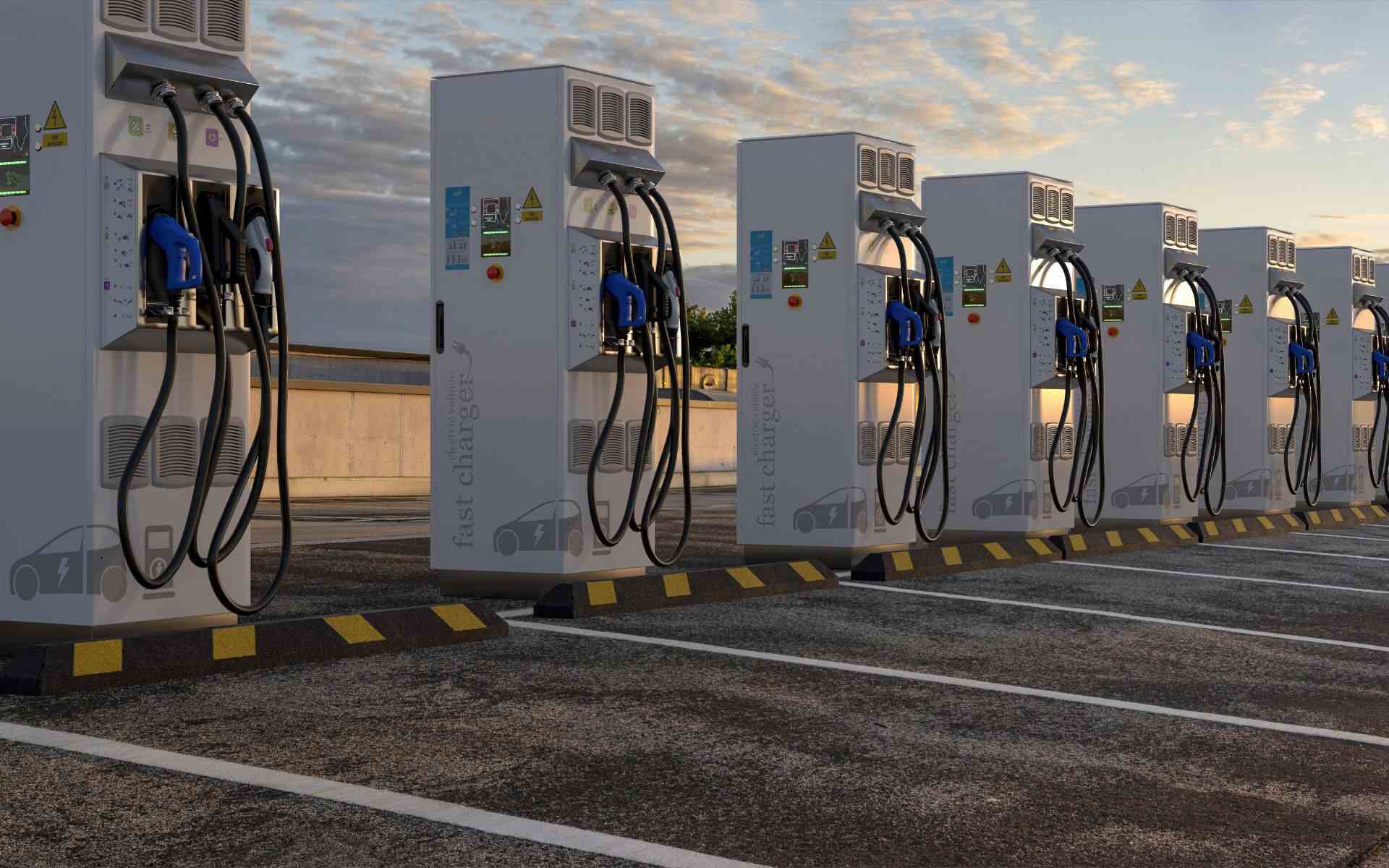
With the growing popularity of electric vehicles, Level 3 EV charging stations—also known as DC Fast Charging stations—are becoming more accessible across highways, cities, and retail locations. Still, coverage isn’t uniform everywhere, so knowing where to find reliable fast charging is essential for EV owners who travel frequently or lack access to home charging.
Popular Charging Networks Offering Level 3 Charging
Several major networks operate fast-charging infrastructure across North America and other regions:
| Charging Network | Level 3 Available? | App/Locator Tool | Coverage Highlights |
|---|---|---|---|
| Tesla Supercharger | Yes (NACS) | Tesla app | High-speed, exclusive to Tesla (CCS supported in some stations) |
| Electrify America | Yes (CCS, CHAdeMO) | EA app, PlugShare | Wide highway and city coverage |
| EVgo | Yes (CCS, CHAdeMO, NACS) | EVgo app | Urban-focused, growing rapidly |
| ChargePoint | Some locations | ChargePoint app | Mixed Level 2 & Level 3 sites |
| FLO, Greenlots, Shell Recharge | Yes | Varies by region | Mostly regional or expanding |
Pro tip: Use apps like PlugShare, A Better Routeplanner (ABRP), and Chargeway to plan trips and filter for Level 3 (DCFC) stations only.
Best Locations to Find DC Fast Chargers
- Highway Corridors:
Most Level 3 chargers are placed along interstates and major highways to support long-distance travel. - Retail and Grocery Stores:
Retailers like Walmart, Target, and grocery chains increasingly host fast-charging stations as part of public-private partnerships. - EV Charging Hubs:
Some cities have built dedicated EV charging plazas with multiple Level 3 units, amenities, and 24/7 access. - Car Dealerships and Service Centers:
Tesla, Nissan, and select Ford or Hyundai dealerships often host fast chargers for both customers and public use.
Government-Funded Infrastructure Initiatives
Governments in many countries are heavily investing in EV infrastructure. In the U.S., for example:
- The National Electric Vehicle Infrastructure (NEVI) program is funding Level 3 stations every 50 miles along major highways.
- State-level rebates and incentives also support the installation of fast chargers in underserved regions.
These initiatives are designed to reduce range anxiety and promote EV adoption by expanding high-speed charging access.
Reliability and Uptime: What to Expect
Not all fast chargers are equal in quality or uptime. Before heading to a station:
- Check reviews and live status via charging apps
- Look for stations with multiple chargers (reduces wait time)
- Prefer well-maintained, high-traffic locations
Pros and Cons of Level 3 EV Charging
While Level 3 EV charging—or DC Fast Charging—offers impressive speed and convenience, it’s not the ideal solution for every EV owner in every situation. Like most technologies, it comes with a clear set of advantages and limitations that are important to understand before relying on it for your regular charging routine.
Pros of Level 3 Charging
1. Ultra-Fast Charging Speeds
The most obvious benefit is speed. Level 3 chargers can restore up to 80% of your battery in just 15 to 40 minutes, depending on your vehicle. This is ideal for:
- Long-distance travel
- Emergency top-ups
- Commercial fleet operations
2. Public Availability Along Major Routes
Many Level 3 stations are placed at strategic highway locations, reducing range anxiety for drivers planning road trips. Networks like Electrify America and Tesla Superchargers offer nationwide coverage in the U.S., with similar expansion in Europe and Asia.
3. Supports High-Volume Use
Level 3 charging is essential for:
- Taxis and ride-sharing fleets
- Delivery vehicles
- Transit and heavy-duty EVs
These vehicles benefit from quick turnaround times that Level 2 cannot support.
4. Enables EV Adoption Without Home Charging
Urban EV drivers without access to garage outlets or driveway chargers can rely on fast charging to stay mobile without home infrastructure.
Cons of Level 3 Charging
1. Higher Cost per Session
Compared to Level 2 home charging, which can cost as little as $1–$3 per night, Level 3 charging may cost $12–$30 per session. It’s convenient, but not cheap for daily use.
2. Battery Health Impact
Frequent use of high-speed DC charging can lead to faster battery degradation over time, especially in vehicles without active thermal management or older battery chemistries.
3. Not Universally Compatible
Not all EVs support Level 3 charging. Most plug-in hybrids (PHEVs) and some older BEVs lack the hardware. Additionally, the connector standard (CCS, CHAdeMO, NACS) can limit where you charge.
4. Not Practical for Home Installation
Due to infrastructure requirements (480V+ grid access, expensive hardware, utility permits), Level 3 chargers are not suitable for residential use.
5. Limited Availability in Some Regions
Outside of metro areas and highways, Level 3 chargers are still sparse—especially in rural regions or developing EV markets. Access can also be limited by broken units or long wait times during peak hours.
Future of Level 3 EV Charging Technology
As electric vehicles evolve, so too must the infrastructure that powers them. Level 3 EV charging, also known as DC Fast Charging, is undergoing rapid transformation to meet growing demand, reduce charging time, and integrate more clean energy into the grid. The next decade will bring faster, smarter, and more accessible charging—here’s what to expect.
1. Ultra-Fast Charging with 800V and 1000V Architectures
New EVs are moving beyond the traditional 400V systems. High-performance vehicles like the Hyundai Ioniq 5, Kia EV6, and Porsche Taycan use 800V electrical platforms, allowing them to:
- Accept up to 270–350 kW of DC power
- Recharge 10–80% in under 20 minutes
- Reduce charging cable size and weight
Even 1000V systems are in development, enabling sub-10-minute charging times in the near future.
2. Widespread Adoption of NACS (Tesla’s Connector)
The North American Charging Standard (NACS), initially developed by Tesla, is rapidly becoming the new default:
- Ford, GM, Rivian, and Hyundai plan to adopt NACS ports starting in 2025
- Charging networks (like Electrify America and EVgo) are adding NACS-compatible plugs
- This move will unify the charging experience, reduce connector confusion, and expand cross-network compatibility
3. Bi-Directional DC Charging (V2G & V2H)
DC fast chargers are starting to support bi-directional energy flow, enabling:
- Vehicle-to-grid (V2G): Feed power back into the grid during peak demand
- Vehicle-to-home (V2H): Use your EV as a backup energy source during blackouts
While still in its early stages, bi-directional DC charging could transform EVs into mobile energy storage units.
4. Integration with Renewable Energy and Smart Grids
As utilities aim to reduce fossil fuel dependency, Level 3 charging stations are being integrated with:
- Solar canopies and on-site battery storage
- AI-based load management systems
- Smart charging schedules that prioritize off-peak or green energy use
This not only supports sustainability goals but also lowers operational costs for charging providers and drivers alike.
5. Faster, More Reliable User Experience
Future DC fast chargers will feature:
- Plug-and-charge authentication (no app or card needed)
- Real-time availability and dynamic pricing
- Better uptime reliability with remote diagnostics
- Smaller, sleeker designs for urban installations
Expect charging stations to behave more like connected smart infrastructure than isolated utilities.
Conclusion
Level 3 EV charging, also known as DC Fast Charging, has become a critical part of the modern electric vehicle ecosystem. It offers unmatched speed, making long-distance travel and urban EV ownership more convenient than ever. With the ability to deliver up to 80% battery charge in under 30 minutes, Level 3 chargers fill the gap that Level 1 and Level 2 systems can’t address.
However, this speed comes with trade-offs—higher costs, greater stress on battery systems, and compatibility limitations. While it’s not a solution for everyday home charging, it’s ideal for road trips, fleet vehicles, and drivers without access to private infrastructure.
As technology continues to evolve—with faster 800V platforms, unified connector standards like NACS, and smarter grid integration—DC Fast Charging is set to become faster, more efficient, and more accessible than ever before.
For EV owners, the key is understanding when and how to use Level 3 charging effectively. It’s a powerful tool in your charging arsenal—but like any tool, it works best when used wisely.
FAQs About Level 3 EV Charging
Can I install a Level 3 charger at home?
No. Level 3 chargers require industrial-grade power (400V–1000V) and infrastructure not available in residential settings. Homeowners should use Level 2 charging for daily needs.
Is Level 3 charging bad for my EV battery?
Not inherently. Occasional use is safe and supported by most modern EVs. However, excessive use of DC Fast Charging may slightly accelerate battery wear, especially in older EVs without thermal management.
How do I know if my car supports DC Fast Charging?
Check your vehicle’s specifications. Most modern BEVs support DC Fast Charging via CCS, NACS, or CHAdeMO. PHEVs, HEVs, and some early EV models may not be compatible.
How fast is Level 3 charging compared to Level 2?
Level 3 charging is significantly faster—adding 60–250+ miles of range in 15–40 minutes, while Level 2 typically adds 20–40 miles per hour of charging.
Are Tesla Superchargers Level 3?
Yes. Tesla Superchargers are Level 3 DC Fast Chargers that use the NACS connector. Many are now also being equipped with CCS adapters to support non-Tesla EVs.

